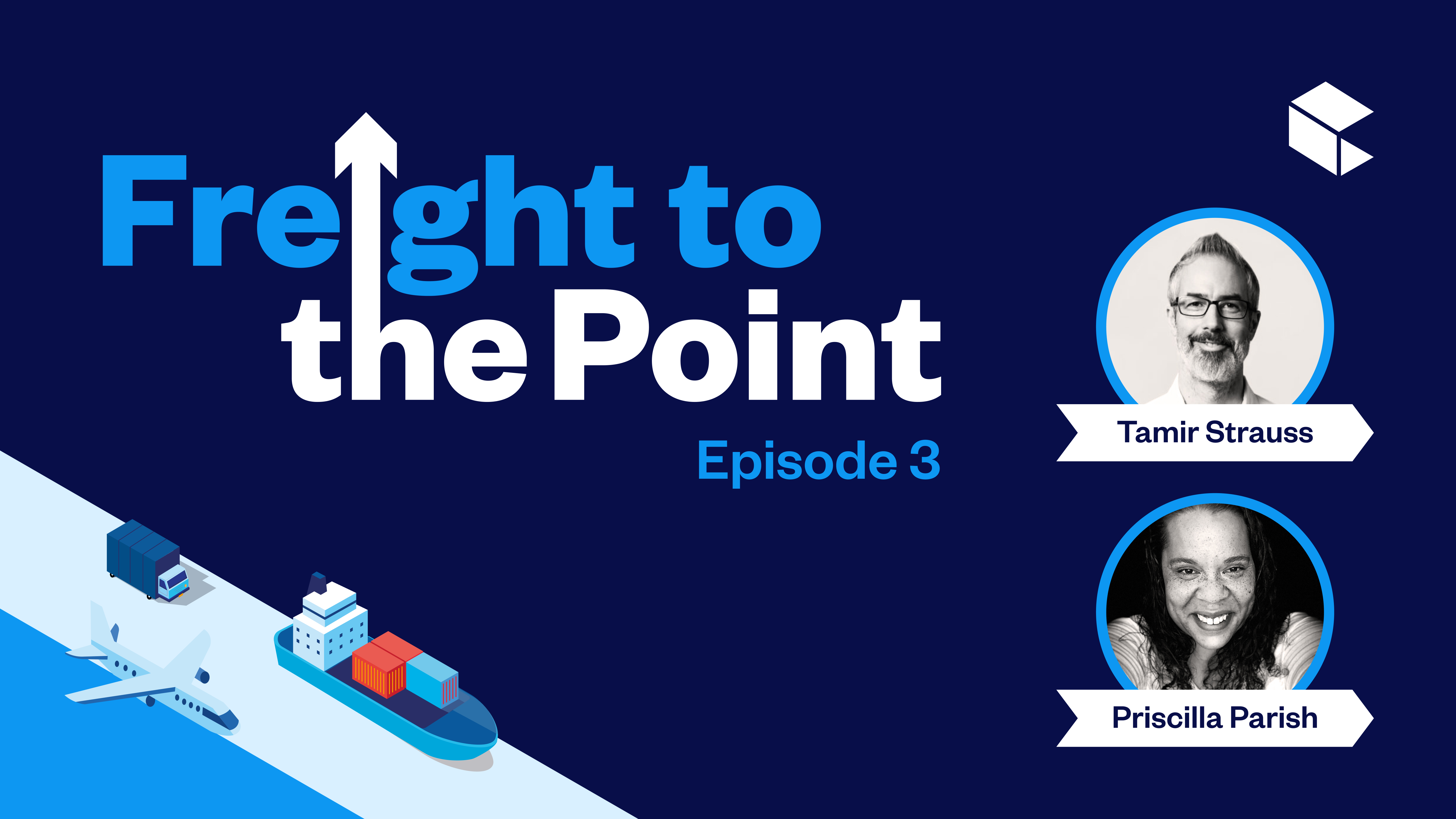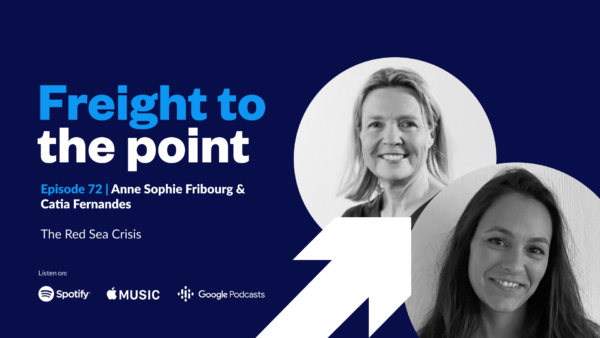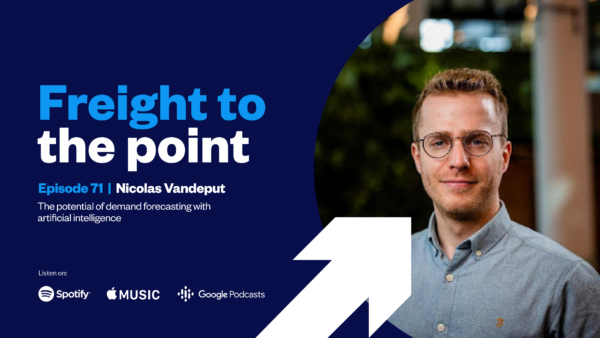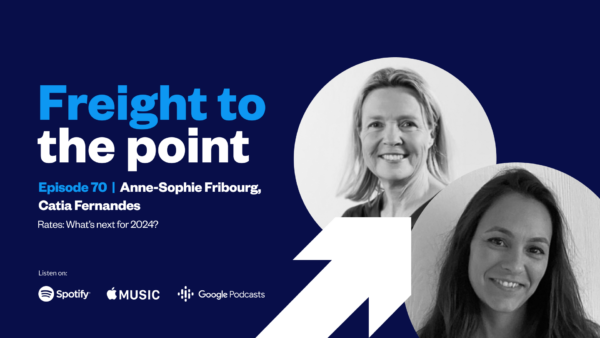Episode 3:
Tamir Strauss and Priscilla Parrish on how to build a smarter supply chain
See all episodes

In Episode 3, we have featured a clip from Navigate Smarter, Zencargo’s supply chain conference for professionals. This episode features Tamir Strauss, Chief Product and Technology Officer at Zencargo and Priscilla Parrish, Head of Logistics at Velocity Commerce.
This session discusses:
- The technical problems they’ve encountered
- The raw ingredients required to start a smarter supply chain
- How the right tools can help add value to the logistics function
Tamir Strauss
Tamir has over 25 years of experience in product and tech, working with companies such as Huma and Snatch before joining Zencargo. Driven by analytical problem solving, strategic thinking and innovating Tamir’s goals focus on improving business processes.
Priscilla Parrish, Head of Logistics, Velocity Commerce
With a focus on international trade, B2C, B2B, and Amazon, Priscilla is extensively experienced in increasing efficiencies and cutting costs in retail supply chains by managing 3PL partners across the globe using data-driven solutions.
Listen to the next episode now
 Hello, and welcome to Episode 3 of Freight to the Point, a podcast by Zencargo. Really excited about our content this week. What we’re going to do is share the really fantastic speaker session that we covered in our Navigate smarter virtual summit back at the end of April. For anyone that has listened to the Navigate sessions that we run once a quarter over the last year. You’ll know that the summit is a conference where a number of leaders across supply chain get together to talk about what disruption looks like in the industry and disruption is likely to look like in the future. The session we’re going to cover today is building for a supply chain and I was lucky enough to be joined by Priscilla Parrish, the amazing Head of Logistics at Velocity Commerce, and our very own Tamir Strauss, the Chief Product and Technology Officer at Zencargo. And we got together to talk about what goes wrong in supply chain, how tech can help supply chain professionals reach their goals and have more ambitious conversations, and how we see the role of tech and supply chain evolving over time. I found the conversation super enjoyable and I hope you enjoy listening to it today.
Hello, and welcome to Episode 3 of Freight to the Point, a podcast by Zencargo. Really excited about our content this week. What we’re going to do is share the really fantastic speaker session that we covered in our Navigate smarter virtual summit back at the end of April. For anyone that has listened to the Navigate sessions that we run once a quarter over the last year. You’ll know that the summit is a conference where a number of leaders across supply chain get together to talk about what disruption looks like in the industry and disruption is likely to look like in the future. The session we’re going to cover today is building for a supply chain and I was lucky enough to be joined by Priscilla Parrish, the amazing Head of Logistics at Velocity Commerce, and our very own Tamir Strauss, the Chief Product and Technology Officer at Zencargo. And we got together to talk about what goes wrong in supply chain, how tech can help supply chain professionals reach their goals and have more ambitious conversations, and how we see the role of tech and supply chain evolving over time. I found the conversation super enjoyable and I hope you enjoy listening to it today. We’re going to talk about building for a smarter supply chain. Priscilla and Tamir, I’m going to hand over to you to introduce yourselves and your backgrounds a little bit. Priscilla, why don’t you kick us off?
We’re going to talk about building for a smarter supply chain. Priscilla and Tamir, I’m going to hand over to you to introduce yourselves and your backgrounds a little bit. Priscilla, why don’t you kick us off?

 Fantastic, thank you Priscilla. Tamir?
Fantastic, thank you Priscilla. Tamir?

 Great, thank you. I’m really looking forward to having this conversation. I’m really looking forward to thinking about how we can pull the data and the tech together. So let’s cast our minds back and Priscilla, I’m gonna send this question over to you first. What technical problems have you personally run up against when it comes to trying to build a reliable supply chain?
Great, thank you. I’m really looking forward to having this conversation. I’m really looking forward to thinking about how we can pull the data and the tech together. So let’s cast our minds back and Priscilla, I’m gonna send this question over to you first. What technical problems have you personally run up against when it comes to trying to build a reliable supply chain?

 It sounds like a headache even before the last two years. And I mean those challenges, I’m sure so many of our audience are going to resonate with them, but for you, what have been some of the most painful consequences of not having sufficient, accurate up to date data? What does that pain feel like?
It sounds like a headache even before the last two years. And I mean those challenges, I’m sure so many of our audience are going to resonate with them, but for you, what have been some of the most painful consequences of not having sufficient, accurate up to date data? What does that pain feel like?


I can completely imagine that not only more valuable things, but probably much more enjoyable things as well.
of preemptively address the situation. And as Priscilla said, this has direct impact on the business, higher costs, lower revenues, all these things.

 That makes such a lot of sense. And I think it was Bjorn earlier on in his session who I think he might have been guessing this number, but I’m gonna trust his guess. He has estimated that 80% of supply chain professionals are still working in Excel. And Priscilla, I know when we spoke before you when mentioned Excel, the tool we love to love, but love to hate, was such a big part of supply chain. And disparate systems, not only Excel, seem to be a challenge. Tell us a bit more about the time that you see being lost just through Excel alone.
That makes such a lot of sense. And I think it was Bjorn earlier on in his session who I think he might have been guessing this number, but I’m gonna trust his guess. He has estimated that 80% of supply chain professionals are still working in Excel. And Priscilla, I know when we spoke before you when mentioned Excel, the tool we love to love, but love to hate, was such a big part of supply chain. And disparate systems, not only Excel, seem to be a challenge. Tell us a bit more about the time that you see being lost just through Excel alone.

 And of course the tool’s only going to be as accurate as the, the recency and the accuracy of the data you’re even putting into it in the first place.
And of course the tool’s only going to be as accurate as the, the recency and the accuracy of the data you’re even putting into it in the first place.
clean and accurate before you even can attempt to think about improving your supply chain or taking on onboard those innovations, because your data might be pointing to the wrong technology improvement. You know, it might be saying, ‘Hey, go get robots’, but it’s not what you need in order to improve your supply chain.

 A lot of the things that we’re saying are causing pain points. I can’t imagine it’s a surprise to lots of people in this session. Lack of visibility, lack of timely or accurate data, disparate systems, multiple suppliers in multiple members of the process that aren’t speaking. I think we know it, and I think we probably have all felt it in some way or another, but it’s often challenging to even think about how to overcome so many hurdles when you’re facing them all at once. I’ll go first to Priscilla, I’m sure you’d love to build on this, but if you were to go back to first principles and, what are the raw ingredients required to build that smarter supply chain kind of from the ground up? And how would you approach that? We’d love to hear your insight there.
A lot of the things that we’re saying are causing pain points. I can’t imagine it’s a surprise to lots of people in this session. Lack of visibility, lack of timely or accurate data, disparate systems, multiple suppliers in multiple members of the process that aren’t speaking. I think we know it, and I think we probably have all felt it in some way or another, but it’s often challenging to even think about how to overcome so many hurdles when you’re facing them all at once. I’ll go first to Priscilla, I’m sure you’d love to build on this, but if you were to go back to first principles and, what are the raw ingredients required to build that smarter supply chain kind of from the ground up? And how would you approach that? We’d love to hear your insight there.

 Makes a lot of sense. And Tamir, what are your thoughts on that? How are you approaching the Zencargo product and our product future with this in mind?
Makes a lot of sense. And Tamir, what are your thoughts on that? How are you approaching the Zencargo product and our product future with this in mind?
For us, a main kind of goal and trajectory that the product is already on is making sure that we’re able to really, really reflect everything that’s happening as accurately as possible without making any compromising compromises and any assumptions hidden the system that prevent us from reflecting what is actually happening in reality. The workflows are very complimentary to this, but we’ve come to realize that in order to increase efficiency in order to facilitate better operations, better service interaction with the customer, interaction with other third parties that are involved in kind of moving stuff.
get the best out of the system, but also we’ll give them the best kind of service that we can. And the last area which we kind of touched on is, is bringing it all together by connecting as many systems as possible.

 Amazing, thank you. And Priscilla, I was seeing a lot of nodding while Tamir was running through that journey from the digital twin, the customisable workflows, and then connecting your network. Tell us a little bit around, you know, you’ve been using this tool for a while now in your business, what’s different following using Zencargo in the business?
Amazing, thank you. And Priscilla, I was seeing a lot of nodding while Tamir was running through that journey from the digital twin, the customisable workflows, and then connecting your network. Tell us a little bit around, you know, you’ve been using this tool for a while now in your business, what’s different following using Zencargo in the business?
basically open up a whole new world for them has been almost, I mean, it makes me feel like a rock star. It makes me look like a rockstar which I can never complain about.

 Well, you know, what if the least that we can do is make you feel like a rockstar, it’s a win, but it’s such a good point. Because it’s such a good point because I think, something that we’re seeing time and time again, and the last two years has highlighted this possibly more than ever before, is supply chain professionals are the rock stars often in the back office of the building. And there are so many opportunities for us to add value to businesses through supply chain. And I’m just thinking of the potential for all of the supply chain professionals on this call. Were they equipped with the right tools with the right infrastructure, with the right resources and ultimately the right data? What do you think are the sort of different ways in which supply chain professionals add additional value to the business?
Well, you know, what if the least that we can do is make you feel like a rockstar, it’s a win, but it’s such a good point. Because it’s such a good point because I think, something that we’re seeing time and time again, and the last two years has highlighted this possibly more than ever before, is supply chain professionals are the rock stars often in the back office of the building. And there are so many opportunities for us to add value to businesses through supply chain. And I’m just thinking of the potential for all of the supply chain professionals on this call. Were they equipped with the right tools with the right infrastructure, with the right resources and ultimately the right data? What do you think are the sort of different ways in which supply chain professionals add additional value to the business?
were able to make sure there were no shortages in our chain.

 It makes so much sense. And I think in terms of just data giving you ability to have new conversations, I bet some of your suppliers are quaking in their boots when they know you’re looking at those dashboards. And Tamir, what do you think about the ability of supply chain professionals to add value to the business? How do you see tools, resource, and data helping them do that?
It makes so much sense. And I think in terms of just data giving you ability to have new conversations, I bet some of your suppliers are quaking in their boots when they know you’re looking at those dashboards. And Tamir, what do you think about the ability of supply chain professionals to add value to the business? How do you see tools, resource, and data helping them do that?
I think we perceive this in multiple ways. So the optimisation that Priscilla was mentioning around container utilisation is one avenue where you can basically reduce costs either by producing the number of containers that you’re shipping, maybe using ocean instead of air. If something is not urgent, if you had enough information to know when the product is needed, you could actually make that decision and reduce both the cost.

 Which makes so much sense. It’s so lovely to hear us talking about supply chain professionals, shining and being rock stars. I really hope that the last couple of years and I think from a Zencargo perspective, we really believe in the potential of the supply chain professional and the role of the Chief Supply Chain Officer, who has a seat at the table, who influences business strategy. And the time has come for the, the back office to move in and to really take that place. Thank you.
Which makes so much sense. It’s so lovely to hear us talking about supply chain professionals, shining and being rock stars. I really hope that the last couple of years and I think from a Zencargo perspective, we really believe in the potential of the supply chain professional and the role of the Chief Supply Chain Officer, who has a seat at the table, who influences business strategy. And the time has come for the, the back office to move in and to really take that place. Thank you.
The tech that we use in my department I wouldn’t say that it differs very much. It’s just what I’m looking at and what I’m using to extrapolate the things that I need and to get the raw data and make it into something that is presentable to the wider business.

 I think that’s such a great answer. And I love your analogy of the camera, because ultimately you’re all looking at the same image, but with those different lenses that enables you to all find success. I think that’s a really lovely way of thinking about it. And so another question for you: someone’s asking what in particular has made you feel like a rock star with the visibility you’ve built in?
I think that’s such a great answer. And I love your analogy of the camera, because ultimately you’re all looking at the same image, but with those different lenses that enables you to all find success. I think that’s a really lovely way of thinking about it. And so another question for you: someone’s asking what in particular has made you feel like a rock star with the visibility you’ve built in?
have in this place at this given moment’. And that was revolutionary for an up and coming business.

 I mean, I could talk all day about container utilisation with you and you could probably talk even more than I could because I know you’re so passionate about it. But you made me think about another question, which is, I wonder whether you’re finding anything challenging in some of the interactions that you’re having in the business now, as you take on that new role. So you spoke about the conversation that says, ‘I’ve got the data’. ‘I can see what’s going on, you’re leaving money on the table’. Has it changed the nature of any of your stakeholder relationships?
I mean, I could talk all day about container utilisation with you and you could probably talk even more than I could because I know you’re so passionate about it. But you made me think about another question, which is, I wonder whether you’re finding anything challenging in some of the interactions that you’re having in the business now, as you take on that new role. So you spoke about the conversation that says, ‘I’ve got the data’. ‘I can see what’s going on, you’re leaving money on the table’. Has it changed the nature of any of your stakeholder relationships?

 Makes a lot of sense. Tamir, this is a question I think for you. Is blockchain being used for the enhanced visibility between the different parties in the transactions, or is there any potential for blockchain to be used in the supply chain visibility journey?
Makes a lot of sense. Tamir, this is a question I think for you. Is blockchain being used for the enhanced visibility between the different parties in the transactions, or is there any potential for blockchain to be used in the supply chain visibility journey?
the same blockchain or have blockchains that are connected to each other, which is another big
conversation to have at some point.

 That’s makes a lot of sense. I’m going to say, if anyone wants to join the blockchain and supply chain debate with Tamir, I would jump on into LinkedIn. I’m sure he’s very willing to have the conversation and he is definitely more qualified than I am. So Tamir, thank you for tackling that blockchain question.
That’s makes a lot of sense. I’m going to say, if anyone wants to join the blockchain and supply chain debate with Tamir, I would jump on into LinkedIn. I’m sure he’s very willing to have the conversation and he is definitely more qualified than I am. So Tamir, thank you for tackling that blockchain question.

Basically, you’re the one trying to put us all out of jobs. Thanks Tamir. (Laughs)



 That makes a lot of sense. Thank you so much, Tamir. Thank you so much, Priscilla. Always a rockstar. Great to have you here. Thank you both.
That makes a lot of sense. Thank you so much, Tamir. Thank you so much, Priscilla. Always a rockstar. Great to have you here. Thank you both.
Huge thank you also to our audience for tuning into this episode.

Episode 72: The Red Sea Crisis
In the latest episode of Freight to the Point, we’ve featured our most rec...

Episode 71: The potential of demand forecasting with artificial intelligence
In the most recent instalment of Freight to the Point, Lucie Phillips, Zen...

Episode 70: Rates: What's next for 2024?
As we prepare for the year ahead, it's crucial to consider the three pillars...

